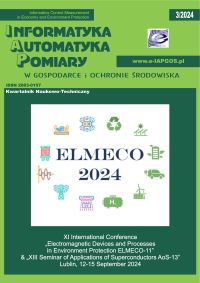WYKRYWANIE SZCZELIN POWIETRZNYCH W CHODNIKU KOPALNI MIEDZI ZA POMOCĄ ELEKTRYCZNEJ TOMOGRAFII IMPEDANCYJNEJ
Tomasz Rymarczyk
tomasz.rymarczyk@netrix.com.plNetrix S.A., Research and Development Center (Polska)
Paweł Tchórzewski
Netrix S.A., Research and Development Center (Polska)
Jan Sikora
Lublin University of Technology, Institute of Electronics and Information Technology; Electrotechnical Institute (Polska)
Abstrakt
W tym artykule przyjrzymy się problemowi odwrotnemu dla pola elektrycznego na tak zwanym problemie kopalni miedzi. Głównym zadaniem w tym zagadnieniu jest wykrycie szczelin powietrznych, które są zlokalizowane w stropie kopalni. Takie zadanie można rozwiązać za pomocą elektrycznej tomografii impedancyjnej. W celu rozwiązania zagadnienia prostego można użyć metody elementów brzegowych (MEB) lub metody elementów skończonych. Zagadnienie odwrotne zostało oparte na metodzie zbiorów poziomicowych. Dla uproszczenia zostały zastosowane elementy zerowego rzędu. Metoda elementów brzegowych została rozszerzona o elementy nieskończone. Stąd problemy otwarte domeny z nieskończonymi brzegami mogą być analizowane. Dla takiej domeny, musimy rozwiązać zagadnienie Dirichleta dla równania dwuwymiarowy Laplace'a. Zaproponowany model numeryczny został zweryfikowany.
Słowa kluczowe:
zagadnienie odwrotne, metoda elementów brzegowych, tomografia impedancyjnaBibliografia
Brebbia C.A., Dominguez J.: Boundary Elements – An Introductory Course, WIT Press, UK, 1992
Google Scholar
Burger M.: Levenberg-Marquardt: Level set methods for inverse obstacle problems, Inverse Problem 20, 2004, 259–282.
Google Scholar
Ito K., Kunish K., Li Z.: The Level-Set Function Approach to an Inverse Interface Problem, 2001, Vol. 17, 11.
Google Scholar
Kythe P.K.: An introduction to Boundary Element Methods, CRC Press, USA, 1995.
Google Scholar
Li C., Xu C., Gui C., Fox M. D.: Level set evolution without re-initialization: A new variational formulation, IEEE Conference on Computer Vision and Pattern Recognition (CVPR), volume 1, 2005, 430–436.
Google Scholar
Osher S., Fedkiw R.: Level Set Methods and Dynamic Implicit Surfaces. Springer, New York 2003.
Google Scholar
Osher, S., Fedkiw, R.: Level Set Methods: An Overview and Some Recent Results. J. Comput. Phys. 169, 2001, 463–502.
Google Scholar
Osher S., Sethian J.A.: Fronts Propagating with Curvature Dependent Speed: Algorithms Based on Hamilton-Jacobi Formulations, Journal of Computational Physics 79, 1988.
Google Scholar
Pańczyk M.: Elementy nieskończone w metodzie elementów brzegowych, PhD thesis, Lublin University of Technology, 2009.
Google Scholar
Pańczyk M., Sikora J.: Geometry and physical quantity transformations in 2D boundary element method with infinite elements, Proceedings of Electrotechnical Institute 3, 2007, 233.
Google Scholar
Rymarczyk T.: Using electrical impedance tomography to monitoring flood banks, International Journal of Applied Electromagnetics and Mechanics 45, 2014, 489–494.
Google Scholar
Rymarczyk T.: Characterization of the shape of unknown objects by inverse numerical methods, Przegląd Elektrotechniczny, R. 88 NR 7b/2012, 138–140.
Google Scholar
Rymarczyk T., Sikora J., Waleska B.: Coupled Boundary Element Method and Level Set Function for Solving Inverse Problem in EIT, 7th World Congress on Industrial Process Tomography, WCIPT7, 2-5 September 2013, Krakow, Poland
Google Scholar
Rymarczyk T., Adamkiewicz P., Duda K., Szumowski J., Sikora J.: New Electrical Tomographic Method to Determine Dampness in Historical Buildings, Achieve of Electrical Engineering 65, 2/2016, 273–283.
Google Scholar
Sethian J.A.: Level Set Methods and Fast Marching Methods. Cambridge University Press, 1999.
Google Scholar
Tai C., Chung E., Chan T.: Electrical impedance tomography using level set representation and total variational regularization. Journal of Computational Physics, vol. 205, no. 1, 2005, 357–372.
Google Scholar
Xia K., Zhang Z.: Three-dimensional finite/infinite elements analysis of fluid flow in porous media, Applied Mathematical Modelling, 30, 6, 2005.
Google Scholar
Autorzy
Tomasz Rymarczyktomasz.rymarczyk@netrix.com.pl
Netrix S.A., Research and Development Center Polska
Autorzy
Paweł TchórzewskiNetrix S.A., Research and Development Center Polska
Autorzy
Jan SikoraLublin University of Technology, Institute of Electronics and Information Technology; Electrotechnical Institute Polska
Statystyki
Abstract views: 194PDF downloads: 48
Licencja

Utwór dostępny jest na licencji Creative Commons Uznanie autorstwa – Na tych samych warunkach 4.0 Miedzynarodowe.
Inne teksty tego samego autora
- Grzegorz Kłosowski, Tomasz Rymarczyk, ZASTOSOWANIE SIECI NEURONOWYCH I ALGORYTMÓW GŁĘBOKIEGO UCZENIA W ELEKTRYCZNEJ TOMOGRAFII IMPEDANCYJNEJ , Informatyka, Automatyka, Pomiary w Gospodarce i Ochronie Środowiska: Tom 7 Nr 3 (2017)
- Tomasz Rymarczyk, Tomasz Cieplak, Grzegorz Kłosowski, Paweł Rymarczyk, PROJEKTOWANIE SYSTEMÓW ANALIZY DANYCH DO AUTOMATYZACJI PROCESÓW BIZNESOWYCH , Informatyka, Automatyka, Pomiary w Gospodarce i Ochronie Środowiska: Tom 8 Nr 3 (2018)
- Tomasz Rymarczyk, Michał Gołąbek, Piotr Lesiak, Andrzej Marciniak, Mirosław Guzik, BUDOWA TOMOGRAFU ULTRADŹWIĘKOWEGO DO ANALIZY PROCESÓW TECHNOLOGICZNYCH W ZAKRESIE FAL ODBITYCH I TRANSMISYJNYCH , Informatyka, Automatyka, Pomiary w Gospodarce i Ochronie Środowiska: Tom 9 Nr 4 (2019)
- Tomasz Rymarczyk, Grzegorz Kłosowski, ZASTOSOWANIE SZTUCZNEJ INTELIGENCJI W ZAUTOMATYZOWANYCH CENTRACH LOGISTYCZNYCH , Informatyka, Automatyka, Pomiary w Gospodarce i Ochronie Środowiska: Tom 8 Nr 1 (2018)
- Tomasz Rymarczyk, Bartek Przysucha, Marcin Kowalski, Piotr Bednarczuk, ANALIZA DANYCH Z CZUJNIKÓW POMIAROWYCH DO PREDYKCJI W SYSTEMACH KONTROLI PROCESÓW PRODUKCYJNYCH , Informatyka, Automatyka, Pomiary w Gospodarce i Ochronie Środowiska: Tom 9 Nr 4 (2019)
- Tomasz Rymarczyk, Krzysztof Polakowski, Jan Sikora, NOWA KONCEPCJA DYSKRETYZACJI MODELU CELEM PODNIESIENIA JAKOŚCI OBRAZOWANIA W TRANSMISYJNEJ TOMOGRAFII ULTRADŹWIĘKOWEJ , Informatyka, Automatyka, Pomiary w Gospodarce i Ochronie Środowiska: Tom 9 Nr 4 (2019)
- Konrad Niderla, Tomasz Rymarczyk, Jan Sikora, SYSTEM PLANOWANIA I KONTROLI PRODUKCJI Z WYKORZYSTANIEM CZUJNIKÓW TOMOGRAFICZNYCH , Informatyka, Automatyka, Pomiary w Gospodarce i Ochronie Środowiska: Tom 8 Nr 3 (2018)
- Tomasz Rymarczyk, Jan Sikora, CAŁKI OSOBLIWE W METODZIE ELEMENTÓW BRZEGOWYCH DLA RÓWNANIA HELMHOLTZA SFORMUŁOWANEGO W PRZESTRZENI CZĘSTOTLIWOŚCI , Informatyka, Automatyka, Pomiary w Gospodarce i Ochronie Środowiska: Tom 11 Nr 4 (2021)
- Grzegorz Kłosowski, Tomasz Rymarczyk, ZASTOSOWANIE KONWOLUCYJNYCH SIECI NEURONOWYCH W IDENTYFIKACJI ZAWILGOCEŃ ŚCIAN BUDYNKÓW METODĄ EIT , Informatyka, Automatyka, Pomiary w Gospodarce i Ochronie Środowiska: Tom 12 Nr 1 (2022)
- Tomasz Rymarczyk, Jan Sikora, JESZCZE O CAŁKOWANIU LOGARYTMICZNYCH OSOBLIWOŚCI W METODZIE ELEMENTÓW BRZEGOWYCH , Informatyka, Automatyka, Pomiary w Gospodarce i Ochronie Środowiska: Tom 14 Nr 1 (2024)








